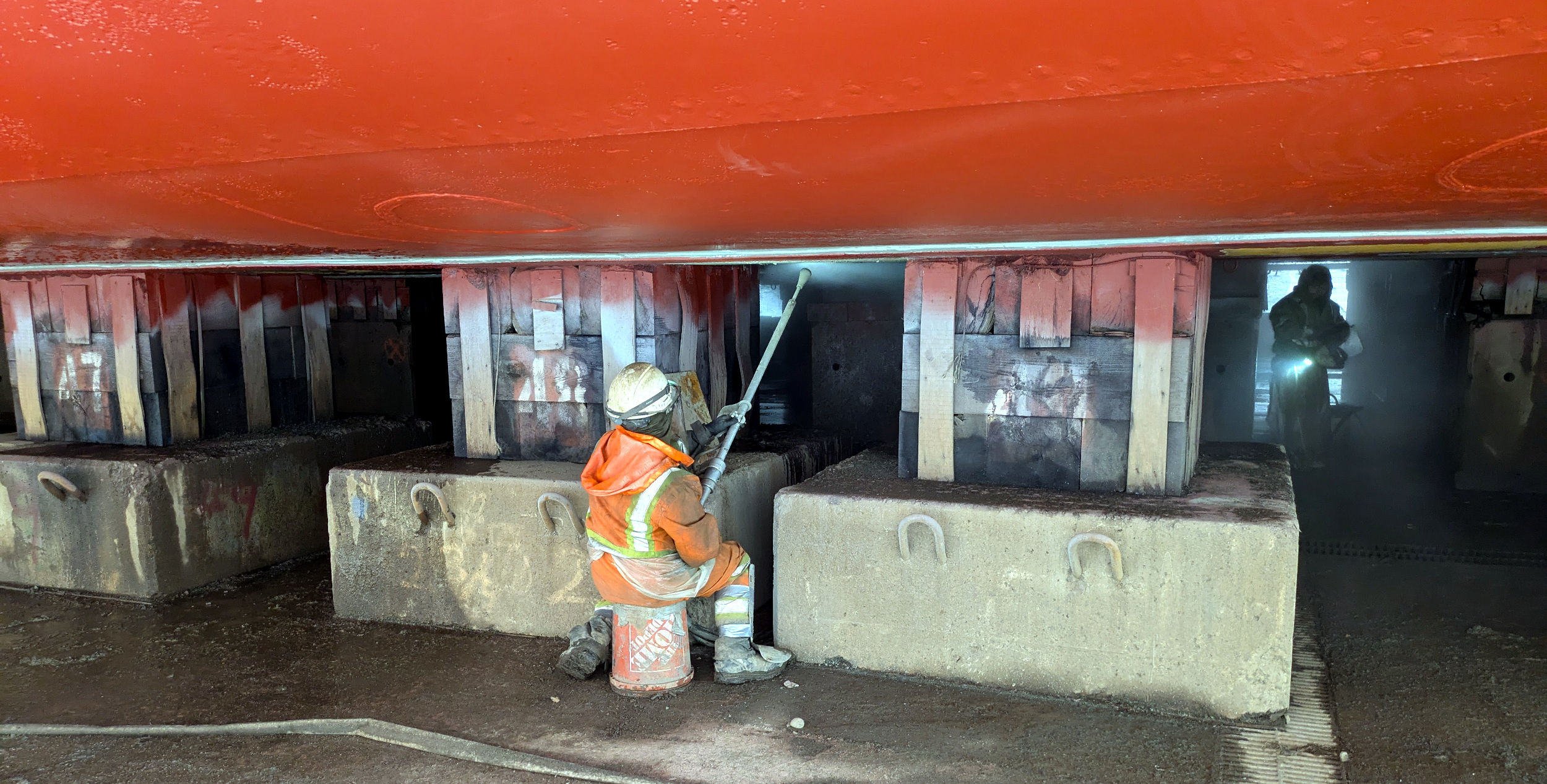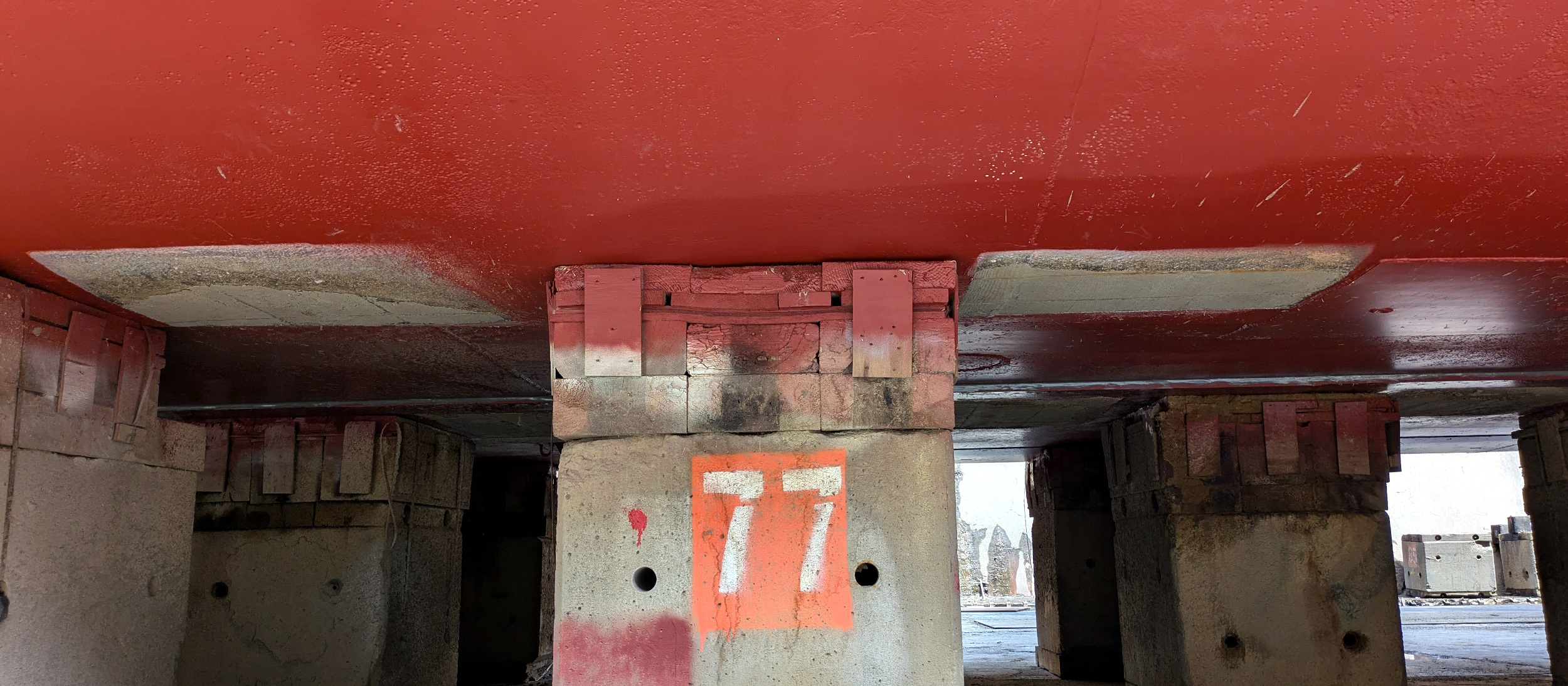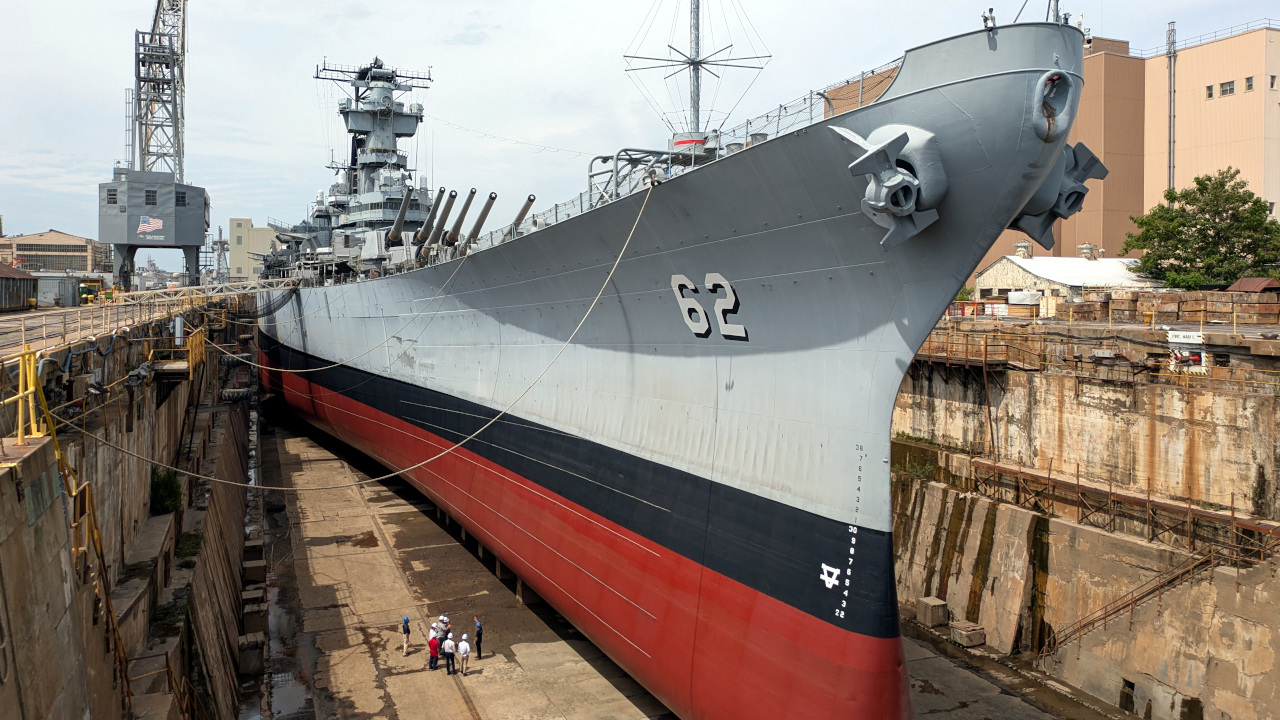By the time you read this the Iowa-class battleship USS New Jersey (BB-62) should be making its way along the Delaware River, heading back to its permanent mooring on the Camden waterfront after undergoing a twelve week maintenance and repair period at the nearby Philadelphia Navy Yard.
The 888 foot (270 meter) long ship won’t be running under its own power, but even under tow, it’s not often that you get to see one of the world’s last remaining battleships on the move. The New Jersey’s return home will be a day of celebration, with onlookers lining the banks of the Delaware, news helicopters in the air, and dignitaries and veterans waiting eagerly to greet her as she slides up to the pier.
 But when I got the opportunity to tour the New Jersey a couple weeks ago and get a first-hand look at the incredible preservation work being done on this historic ship, it was a very different scene. There was plenty of activity within the cavernous Dry Dock #3 at the Navy Yard, the very same slip where the ship’s construction was completed back in 1942, but little fanfare. Staff from North Atlantic Ship Repair, the company that now operates the facility, were laboring feverishly over the weekend to get the ship ready.
But when I got the opportunity to tour the New Jersey a couple weeks ago and get a first-hand look at the incredible preservation work being done on this historic ship, it was a very different scene. There was plenty of activity within the cavernous Dry Dock #3 at the Navy Yard, the very same slip where the ship’s construction was completed back in 1942, but little fanfare. Staff from North Atlantic Ship Repair, the company that now operates the facility, were laboring feverishly over the weekend to get the ship ready.
While by no means an exhaustive account of the work that was done on the ship during its time in Dry Dock #3, this article will highlight some of the more interesting projects that were undertaken while it was out of the water. After seeing the thought and effort put into every aspect of the ship’s preservation by curator Ryan Szimanski and his team, there’s no doubt that not only is the USS New Jersey in exceptionally capable hands, but that it will continue to proudly serve as a museum and memorial for decades to come.
A Fresh Coat of Paint
The primary goal of putting New Jersey into dry dock was to repaint the hull below the water line, something which had not been done since the ship was deactivated by the US Navy in 1990. Under normal circumstances this is the sort of routine maintenance that would be done every few years, but for a static museum ship, the recommended dry docking interval is 30 years. There was no indication that the hull was in particularly bad shape or in need of emergency repair — most of the work done during this yard period was preventative in nature.
The first step in this process was to remove the old paint, along with any biological growth and rust. Unfortunately, there’s no “easy” way to do this. The entire surface area of the underwater hull, totaling roughly 125,000 square feet (11,600 square meters), was painstakingly cleaned using ultra-high pressure washers operating at approximately 30,000 psi. In some areas, getting close enough to the surface of the hull meant putting workers up on a lift, but for the ship’s relatively flat bottom, personnel had to squat down and spray the surface over their heads.

As the ship is resting on around 300 “keel blocks”, this process had to be done in two separate phases. First, the approximately 90% of the hull that was not covered by the blocks was stripped, painted, and left to dry. Then the dry dock was flooded just enough to get the ship floating , so it could be pulled forward a few feet and dropped back down to uncover the areas of the hull that were previously covered.

Checking for Leaks
Even though the steel of the hull itself might be intact, a large ship will have many openings under the water line that can leak if not properly maintained. According to Ryan the New Jersey has about 165 such openings, ranging from tiny drain lines to massive seawater intakes. While the ship was in operation each one of them would have served an important purpose, but as a floating museum with essentially no operating hardware onboard, they’re a liability.
The easiest solution would have been to simply weld plates over all of them. But part of the arrangement that allows the New Jersey to operate as a museum is that the Navy has the right to take the ship back and reactivate it at any time. Admittedly it’s an unlikely prospect, but those are the rules.
Permanently blocking up all those critical openings would make the ship’s reactivation that much more difficult, so instead, each one was “boxed over” with a custom-made steel enclosure. The idea is that, should the ship ever need to return to operation, these boxes could easily be cut off without damaging the hull.


Only one of these boxes was known to be leaking before pulling New Jersey out of the water, but out of an abundance of caution, the integrity of each one was manually checked by pressurizing them with air. If the box held pressure, it was good to go. If it lost air, then it was sprayed with soapy water and closely inspected for bubbles. If there were no bubbles on the outside that meant the air was leaking into the ship through whatever the enclosed fitting was — a problem the Navy might need to address in World War Three, but not something the museum needed to concern themselves with.
Swapping Out Anodes
To help fight off corrosion ships use a technique known as cathodic protection, which essentially turns the steel of the hull into the cathode of a electrochemical cell. The surrounding water serves as the electrolyte, and blocks made of a metal with a high ionization tendency are mounted to the ship to act as the anode. As electrons flow through this circuit, the sacrificial anode dissolves, sparing the hull and other underwater gear such as the propellers.
New Jersey was fitted with 1,200 anodes when the Navy deactivated her, but unfortunately, they ended up being the wrong type. At the time it was assumed that the ship would be stored in a saltwater port as part of what’s known as the “Mothball Fleet”, so zinc anodes were used. There was no way to know that, a decade later, the ship would be transferred to the fresh waters of the Delaware River to live out the rest of its life as a museum.

These shouldn’t exist.

Because of this, the zinc anodes didn’t corrode away as was intended. In fact when the dry dock was drained, it was revealed that the anodes were in nearly perfect condition. You could even still read the manufacturing info stamped into many of them. On the plus side, they’ll make for excellent souvenirs in the museum’s gift shop. But in terms of corrosion protection, they didn’t do a thing.
Luckily, fresh water is relatively forgiving, so the battleship didn’t suffer too badly for this lack of functioning cathodic protection. Even so, it was decided to install 600 aluminum anodes in place of the originals, which are more suitable for the conditions the ship is stored in.
Closing Off the Shafts
Before New Jersey went in for this yard period, there was some debate about removing its propellers and drive shafts. The idea being that the huge openings in the hull which the shafts pass through were a long-term liability. But not only would this have deviated from the museum’s overall goal of keeping the ship as intact as possible, it would have been a considerable undertaking.


Instead it was decided to seal off where the shafts pass through the hull with custom-made steel enclosures, much like the other openings on the bottom of the ship. In addition, the shafts were wrapped with fiberglass where they pass through the support brackets on the rear of the ship. The fiberglass isn’t expected to be a permanent solution like the steel boxes around the shafts, but should provide at least some measure of protection.
Lots and Lots of Caulk
One of the surprising things discovered upon inspecting the hull of New Jersey was that caulking had been applied to all the seams along the riveted hull plates. At least in theory, this shouldn’t be necessary, as the overlapping plates are designed to be watertight. But if the Navy thought it was worth the time and expense to do it, there must have been a reason.
Sure enough, a dive into the ship’s onboard reference library revealed a document from October of 1990 that described a persistent water intrusion issue on the ship. Basically, water kept getting inside the hull, but they couldn’t figure out where it was coming from. Although the Navy couldn’t actually find any leaks between the hull plates, the document went on to explain that the decision was made to caulk them all anyway in hopes that it would solve the issue.


Since the ship hadn’t been taking on any mysterious water while docked in Camden, it would appear the fix worked. As such, it was decided to re-caulk the roughly 18,000 linear feet (5,500 meters) of plate seams just like the Navy did in 1990. Since the manufacturer of the product was mentioned in the document, the museum was even able to get the exact same caulking used by the Navy 34 years ago.
Views From Dry Dock


Documentation for the Future
Walking along the ship’s massive hull, the projects I’ve listed here were the most obvious to even the untrained eye. But as I said at the start, this isn’t a complete list of the work done to the USS New Jersey during its dry docking. It’s hard to overstate the scale of the restoration work that was accomplished in such a short amount of time. It took years of planning by a team of very dedicated individuals to pull this off.
But you don’t have to take my word for it. Ryan Szimanski and his team have done an incredible job of documenting the entire dry docking process on the ship’s official YouTube channel. Putting all of this information out for the public to view and learn from will undoubtedly inform the restoration efforts on other museum ships going forward, but even if you don’t have a battleship in your backyard, it makes for fascinating viewing.
